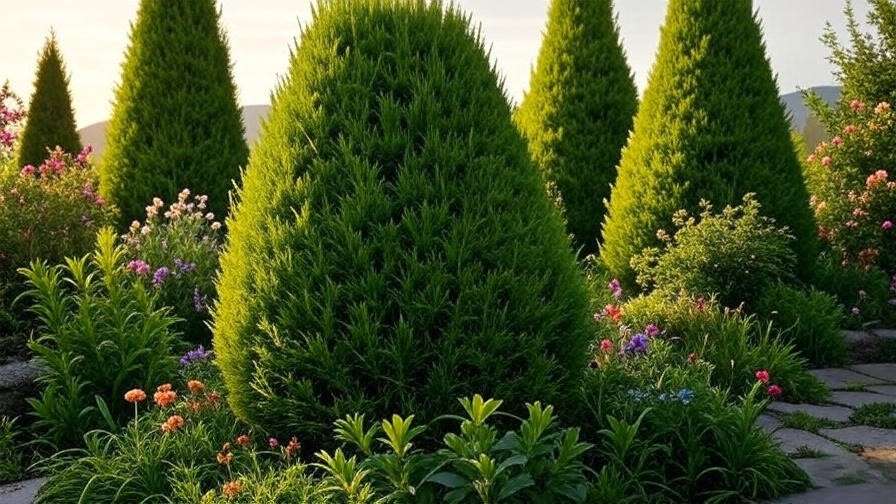Imagine this: you’ve just planted a row of lush cypress shrubs, envisioning a vibrant privacy hedge or a stunning garden focal point. Months later, your dreams are dashed as the shrubs turn brown, wilt, or refuse to grow. What went wrong? Many gardeners, from novices to seasoned enthusiasts, fall into common traps when cultivating cypress shrubs. These evergreen beauties are prized for their versatility and low maintenance, but they’re not foolproof. Mistakes in variety selection, planting, or care can lead to disappointing results or costly replacements. As a horticulturist with over a decade of experience collaborating with arborists and extension services, I’ve seen these pitfalls firsthand. In this guide, we’ll uncover the top 5 mistakes to avoid when planting and caring for cypress shrubs, offering expert-backed solutions to ensure your garden thrives. Whether you’re creating a windbreak or an ornamental masterpiece, this article will help you sidestep errors and grow healthy, vibrant cypress shrubs.
Why Cypress Shrubs Are a Gardener’s Favorite

The Appeal of Cypress Shrubs
Cypress shrubs, known for their dense, evergreen foliage and elegant forms, are a staple in landscapes worldwide. Their versatility makes them ideal for hedges, privacy screens, or standalone features. Varieties like Leyland cypress (Cupressocyparis leylandii), Italian cypress (Cupressus sempervirens), and Hinoki cypress (Chamaecyparis obtusa) offer distinct aesthetics, from towering spires to compact, feathery mounds. According to the USDA, most cypress varieties thrive in hardiness zones 6–10, adapting to diverse climates from coastal regions to arid interiors. Their fast growth—Leyland cypress can grow up to 3 feet per year—and year-round greenery make them a top choice for gardeners seeking beauty and functionality.
Beyond aesthetics, cypress shrubs are relatively low-maintenance when grown correctly. They resist many pests and diseases, tolerate various soil types, and provide excellent wind protection. Their ability to create natural barriers or accentuate garden designs has cemented their popularity among homeowners and landscapers alike.
Common Uses in Landscaping
Cypress shrubs shine in multiple roles. Leyland cypress, for instance, is a go-to for privacy hedges, quickly forming dense screens that block noise and nosy neighbors. Italian cypress, with its slender, columnar shape, adds a Mediterranean flair to formal gardens or urban patios. Hinoki cypress, prized for its soft, fan-like foliage, works beautifully as a specimen plant or in Japanese-inspired landscapes. In rural settings, farmers use cypress as windbreaks to protect crops or livestock, leveraging their height and resilience.
Culturally, cypress trees hold significance in Mediterranean and Asian traditions, symbolizing longevity and protection. Their adaptability makes them suitable for both residential yards and commercial properties, from suburban backyards to office courtyards. By understanding their uses, gardeners can better align their cypress choices with specific landscape goals.
Choosing the Wrong Cypress Variety for Your Garden
Understanding Cypress Varieties
Selecting the right cypress variety is critical, yet it’s where many gardeners stumble. Not all cypress shrubs are created equal—each has unique growth habits, sizes, and environmental needs. Leyland cypress, for example, is a fast-growing hybrid that can reach 50–70 feet if unpruned, making it unsuitable for small yards. Italian cypress, with its narrow, vertical growth, tops out at 30–40 feet but requires full sun and well-draining soil. Hinoki cypress, a slower grower, stays compact (8–12 feet) and thrives in partial shade, ideal for ornamental gardens.
Other varieties, like Arizona cypress (Cupressus arizonica) or Nootka cypress (Chamaecyparis nootkatensis), cater to specific climates or aesthetic preferences. Arizona cypress tolerates arid conditions, while Nootka excels in cooler, wetter regions. Ignoring these differences can lead to mismatched plants that struggle to survive.
How to Choose the Right Variety
To pick the perfect cypress, assess your garden’s conditions and goals. Start by evaluating space: measure available area to ensure the mature size of the shrub won’t overwhelm your landscape. Check your USDA hardiness zone (available via USDA’s online map) to confirm climate compatibility. For example, Leyland cypress thrives in zones 6–10, while Hinoki prefers zones 4–8.
Next, consider purpose. Need a privacy screen? Leyland or Italian cypress are top picks. Want a low-maintenance accent? Hinoki or dwarf varieties like Chamaecyparis pisifera ‘Filifera’ work well. Sun exposure and soil type also matter—most cypresses need full sun (6+ hours daily) and well-draining soil. Consulting local nurseries or extension services can provide region-specific recommendations, ensuring your choice aligns with local conditions.
Expert Tip: Create a shortlist of 2–3 varieties, then cross-reference their growth rates and care needs with your garden’s constraints.
Consequences of a Poor Choice
Choosing the wrong variety can spell disaster. A Leyland cypress in a small urban garden may outgrow its space, crowding out other plants or requiring constant pruning. Conversely, a Hinoki cypress in a windy, exposed site may suffer stunted growth or windburn. Mismatched varieties are also more susceptible to pests like bagworms or diseases like canker, especially if stressed by unsuitable conditions.
To help, here’s a quick-reference table:
| Variety | Mature Height | Hardiness Zone | Ideal Use | Sun Needs |
|---|---|---|---|---|
| Leyland Cypress | 50–70 ft | 6–10 | Privacy hedge, windbreak | Full sun |
| Italian Cypress | 30–40 ft | 7–11 | Ornamental, formal garden | Full sun |
| Hinoki Cypress | 8–12 ft | 4–8 | Specimen, small gardens | Full/partial sun |
| Arizona Cypress | 20–40 ft | 7–9 | Arid landscapes, hedges | Full sun |
Improper Planting Techniques

Common Planting Errors
Planting cypress shrubs seems straightforward, but small errors can have big consequences. A common mistake is planting too deep, burying the root flare (where the trunk meets the roots), which suffocates the plant. Planting too shallow exposes roots, leaving them vulnerable to drying out. Other pitfalls include ignoring the root ball’s size—cramming it into a small hole restricts growth—or failing to prepare the soil, which limits nutrient access. These errors stress the plant, leading to slow growth or early decline.
Best Practices for Planting Cypress Shrubs
Proper planting sets the foundation for healthy cypress shrubs. Follow these steps:
- Choose the Right Spot: Ensure full sun (or partial shade for Hinoki) and well-draining soil. Avoid low-lying areas prone to waterlogging.
- Dig the Perfect Hole: Make it 2–3 times wider than the root ball but no deeper. The root flare should sit slightly above ground level.
- Amend the Soil: Mix native soil with organic compost (1:1 ratio) to improve drainage and fertility.
- Position the Shrub: Place the root ball in the hole, ensuring the flare is visible. Backfill gently, tamping down to eliminate air pockets.
- Water Thoroughly: Soak the area immediately after planting to settle the soil and hydrate the roots.
- Mulch Wisely: Apply 2–3 inches of organic mulch (e.g., bark or wood chips) around the base, keeping it 2 inches from the trunk to prevent rot.
Expert Insight: Exposing the root flare is critical—burying it can cause girdling roots, which choke the plant over time. Use a hand trowel to gently remove excess soil from the root ball if needed.
Timing Matters
Timing your planting maximizes success. Spring and fall are ideal in most climates, allowing roots to establish before summer heat or winter frost. In USDA zones 6–8, early fall planting leverages cooler temperatures and increased rainfall. In warmer zones (9–10), spring planting avoids excessive heat stress. Check your local extension service for precise planting windows, as timing varies by region.
For a visual guide, consider watching a planting tutorial from a reputable source like your state’s cooperative extension program or embedding a diagram showing proper hole depth and mulch placement.
Neglecting Soil and Water Needs

Understanding Soil Requirements
Healthy cypress shrubs depend on the right soil conditions, yet many gardeners overlook this critical factor. Cypress varieties thrive in well-draining, loamy soil with a slightly acidic to neutral pH (5.5–7.0). Heavy clay soils, which retain water, can suffocate roots and promote rot, while overly sandy soils may drain too quickly, starving the plant of nutrients. A common mistake is planting without testing or amending the soil, assuming all dirt is equal. This can lead to poor growth, yellowing foliage, or even plant death.
To optimize soil, start with a simple test. DIY kits, available at garden centers, measure pH and nutrient levels, or you can send samples to your local cooperative extension service for a detailed analysis. If the soil is too compact or clay-heavy, incorporate organic matter like compost or aged manure to improve drainage and aeration.
Watering Do’s and Don’ts
Watering is another area where mistakes are common. Overwatering can cause root rot, especially in poorly draining soils, while underwatering stresses the plant, leading to browning needles or stunted growth. Newly planted cypress shrubs need consistent moisture—about 1 inch of water per week, including rainfall—for the first year to establish roots. Established shrubs are more drought-tolerant but still require occasional deep watering during dry spells.
Here’s a quick guide:
- Newly Planted (First 6–12 Months): Water deeply 2–3 times per week, ensuring the soil stays moist but not soggy. Check soil moisture by inserting a finger 2 inches deep; if dry, water.
- Established Shrubs: Water every 1–2 weeks during dry periods, focusing on deep, infrequent sessions to encourage strong root growth.
- Signs of Trouble: Yellowing or dropping needles may indicate overwatering; wilting or brittle foliage suggests underwatering.
Expert Tip: Use a soaker hose or drip irrigation to deliver water directly to the root zone, minimizing waste and preventing foliage diseases.
Testing and Amending Soil
If your soil test reveals deficiencies, amend accordingly. For acidic soils (pH below 5.5), add lime to raise pH; for alkaline soils (pH above 7.0), incorporate sulfur or organic compost. Fertilize sparingly—cypress shrubs don’t need heavy feeding. A balanced, slow-release fertilizer (e.g., 10-10-10) applied in early spring supports growth without overwhelming the plant. Over-fertilizing can burn roots or cause excessive, weak growth prone to pests.
For a quick-reference watering chart:
| Growth Stage | Watering Frequency | Amount | Notes |
|---|---|---|---|
| Newly Planted | 2–3 times/week | 1–2 gallons/plant | Keep soil consistently moist |
| First Year | 1–2 times/week | 1 inch/week | Adjust based on rainfall |
| Established | Every 1–2 weeks | Deep watering | Water during prolonged dry spells |
Incorrect Pruning and Maintenance

Why Pruning Matters
Pruning is essential for shaping cypress shrubs, promoting healthy growth, and preventing disease, but it’s often done incorrectly. Over-pruning, cutting at the wrong time, or using improper tools can stress the plant or ruin its natural form. Proper pruning enhances air circulation, reduces pest habitats, and maintains the desired size or shape, whether you’re crafting a formal hedge or a specimen plant. Neglecting pruning, on the other hand, can lead to overgrown, leggy shrubs that lose their aesthetic appeal.
Proper Pruning Techniques
Follow these steps to prune cypress shrubs effectively:
- Timing: Prune in late winter or early spring before new growth begins. Avoid pruning in late summer or fall, as this stimulates tender growth vulnerable to frost.
- Tools: Use sharp, clean bypass pruners or hedge shears. Dull tools cause jagged cuts that invite disease.
- Technique: Trim lightly, removing no more than one-third of the foliage at a time. Focus on shaping the outer layer and removing dead or damaged branches. For hedges, taper the sides slightly (wider at the base) to ensure sunlight reaches lower branches.
- Key Rule: Avoid cutting into old wood (brown, non-leafy stems), as most cypress varieties won’t regrow from these areas.
Expert Insight: For Leyland cypress, frequent light trims (2–3 times per growing season) maintain dense foliage better than heavy annual cuts. Always sanitize tools between plants to prevent disease spread.
Ongoing Maintenance Tips
Beyond pruning, regular maintenance keeps cypress shrubs thriving. Apply 2–3 inches of organic mulch (e.g., bark or pine straw) around the base annually to retain moisture, regulate soil temperature, and suppress weeds. Keep mulch 2 inches from the trunk to avoid rot. Inspect shrubs monthly for pests like spider mites (webbing on foliage) or bagworms (small, bag-like structures). Early detection is key to preventing infestations.
Fertilize once a year in spring with a slow-release, balanced fertilizer, and monitor soil moisture during extreme weather. A seasonal maintenance checklist can help:
- Spring: Prune, fertilize, and refresh mulch.
- Summer: Monitor for pests and water during droughts.
- Fall: Clear fallen debris to prevent fungal growth.
- Winter: Protect young shrubs with burlap in harsh climates.
Ignoring Pests and Diseases
Common Cypress Pests and Diseases
Cypress shrubs are relatively resilient, but they’re not immune to pests and diseases. Common threats include:
- Bagworms: Small caterpillars that create spindle-shaped bags, defoliating branches. Look for tiny, silk-covered bags hanging from foliage.
- Spider Mites: Microscopic pests causing stippled, yellowing leaves and fine webbing. Common in hot, dry conditions.
- Canker: A fungal disease causing sunken, discolored bark and dieback. Often triggered by stress or wounds.
- Root Rot: Caused by overwatering or poor drainage, leading to wilting and browning foliage.
Early detection is critical. Regularly inspect your shrubs for symptoms like yellowing needles, sticky residue, or branch dieback.
Prevention and Treatment
Preventing pests and diseases starts with healthy practices. Ensure proper spacing (3–5 feet for most varieties) to improve air circulation and reduce fungal risks. Water at the base, not overhead, to keep foliage dry. For pests, organic options like neem oil or insecticidal soap are effective for early infestations. For severe cases, consult a local nursery for chemical controls, following label instructions carefully.
For diseases like canker, prune affected branches (sterilizing tools between cuts) and improve plant vigor through proper watering and fertilization. Root rot requires improving drainage—consider raised beds if soil is consistently wet. Always remove and dispose of affected plant material to prevent spread.
Expert Tip: Rotate pest control methods (e.g., alternating neem oil with soap) to prevent resistance, and consult extension services for region-specific pest alerts.
Building Resilience
Healthy cypress shrubs are less susceptible to pests and diseases. Maintain optimal soil conditions, avoid overwatering, and prune regularly to reduce stress. Companion planting with pest-repellent plants like marigolds or lavender can deter insects naturally. A quick-reference table for identification and treatment:
| Issue | Symptoms | Treatment | Prevention |
|---|---|---|---|
| Bagworms | Silk bags, defoliation | Hand-pick bags, apply neem oil | Inspect regularly, prune debris |
| Spider Mites | Yellowing, webbing | Insecticidal soap, increase humidity | Water during dry spells |
| Canker | Sunken bark, dieback | Prune affected areas, fungicide | Avoid wounds, improve air flow |
| Root Rot | Wilting, browning roots | Improve drainage, reduce watering | Test soil drainage before planting |
Bonus Tips for Thriving Cypress Shrubs
To take your cypress shrubs to the next level, consider these advanced strategies:
- Companion Planting: Pair cypress with low-growing perennials like lavender or ornamental grasses to enhance aesthetics and deter pests.
- Wind Protection: In exposed areas, install temporary windbreaks (e.g., burlap screens) for young shrubs during their first winter.
- Winter Care: In colder zones (4–6), wrap young cypress in burlap to prevent windburn or snow damage.
- Sustainable Practices: Opt for drought-tolerant varieties like Arizona cypress in arid regions to conserve water.
Case Study: A homeowner in Zone 7 transformed their backyard with a Leyland cypress hedge. By choosing the right variety, spacing plants 5 feet apart, and following a strict watering schedule, they achieved a 10-foot privacy screen in three years. Regular pruning and pest checks kept the hedge vibrant and healthy.
Frequently Asked Questions (FAQs)
Here are answers to common questions gardeners ask about cypress shrubs, designed to address concerns and reinforce your confidence in growing these versatile evergreens:
- How fast do cypress shrubs grow?
Growth rates vary by variety. Leyland cypress is among the fastest, adding 2–3 feet per year under ideal conditions (full sun, well-draining soil). Italian cypress grows 1–2 feet annually, while Hinoki cypress is slower, gaining 6–12 inches per year. Proper care, including adequate water and nutrients, maximizes growth. - Can cypress shrubs survive in shade?
Most cypress varieties, like Leyland and Italian cypress, require full sun (6+ hours daily) for optimal growth. Hinoki cypress tolerates partial shade (4–6 hours of sun) but may grow more slowly in low light. Avoid planting in full shade, as it leads to sparse foliage and weak growth. - What’s the best fertilizer for cypress shrubs?
Use a balanced, slow-release fertilizer (e.g., 10-10-10) in early spring. Apply sparingly—about 1 pound per 100 square feet—to avoid over-fertilization, which can cause weak, pest-prone growth. Organic options like compost or aged manure also work well to enrich soil naturally. - How do I know if my cypress shrub is healthy?
Healthy cypress shrubs have vibrant green or bluish-green foliage, no significant browning, and steady growth. Check for pests, diseases, or stress signs (yellowing, wilting) monthly. If unsure, consult a local extension service for a professional assessment. - Can I plant cypress shrubs near my house?
Yes, but ensure proper spacing. Fast-growing varieties like Leyland cypress need 5–10 feet from structures to avoid root damage or overcrowding. Compact varieties like Hinoki can be planted closer (3–5 feet) but monitor root growth near foundations.
These answers draw from horticultural research and practical experience, ensuring you have reliable guidance for your cypress shrubs.
Conclusion
Cypress shrubs can transform your garden into a lush, evergreen oasis, but avoiding common mistakes is key to their success. By choosing the right variety, planting correctly, meeting soil and water needs, pruning thoughtfully, and staying vigilant against pests and diseases, you’ll ensure your cypress shrubs thrive for years. Each step—from selecting a climate-appropriate variety like Leyland or Hinoki cypress to maintaining proper drainage—builds a foundation for healthy, vibrant plants. As a horticulturist collaborating with university extension programs, I’ve seen these strategies turn struggling shrubs into stunning landscapes.
Now it’s your turn to apply these tips. Start by assessing your garden’s conditions and choosing a cypress variety that fits your vision. Follow the planting and care guidelines outlined here, and don’t hesitate to reach out to local nurseries or extension services for tailored advice. Have a cypress success story or a question? Share it in the comments below, or explore our related articles on evergreen care and soil health for more gardening insights. With the right approach, your cypress shrubs will be the envy of the neighborhood.













